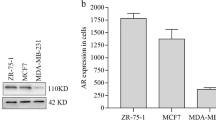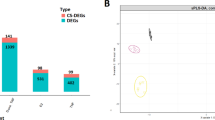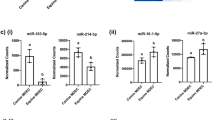Abstract
The effects of tamoxifen, three of its in vivo metabolites and 3-hydroxytamoxifen on cellular proliferation and the induction of four oestrogen-regulated RNAs (pNR-1, pNR-2, pNR-25 and cathepsin D) have been measured in MCF-7 breast cancer cells in phenol red-free culture medium. Tamoxifen and 3-hydroxytamoxifen acted as partial oestrogens to stimulate cell growth and the levels of the pNR-2 and pNR-25 RNAs. They were full oestrogens for the induction of cathepsin D RNA and induced the pNR-1 RNA above the level found in oestrogen-treated cells. N-Desmethyltamoxifen and 4-hydroxytamoxifen behaved like tamoxifen except that N-desmethyltamoxifen did not induce the pNR-2 RNA and was only a partial oestrogen for the induction of cathepsin D RNA, and 4-hydroxytamoxifen did not induce the pNR-2 or pNR-25 RNAs. In the presence of oestradiol, the four anti-oestrogens prevented the stimulation of growth and reduced (pNR-2 and pNR-25) or increased (pNR-1) the RNA levels to those present in MCF-7 cells treated with the anti-oestrogen alone. In contrast, for cathepsin D RNA levels there was a synergistic effect of the anti-oestrogens and oestradiol. The concentration at which each anti-oestrogen was effective was related to its affinity for the oestrogen receptor. Metabolite E was a full oestrogen for the induction of cell proliferation and the oestrogen-regulated RNAs. pNR-25 and pNR-2 RNA levels correlated most closely with effects on cell proliferation. These RNAs are therefore potentially the most useful for predicting the response of breast cancer patients to tamoxifen therapy.
This is a preview of subscription content, access via your institution
Access options
Subscribe to this journal
Receive 24 print issues and online access
$259.00 per year
only $10.79 per issue
Buy this article
- Purchase on Springer Link
- Instant access to full article PDF
Prices may be subject to local taxes which are calculated during checkout
Similar content being viewed by others
Author information
Authors and Affiliations
Rights and permissions
About this article
Cite this article
Johnson, M., Westley, B. & May, F. Oestrogenic activity of tamoxifen and its metabolites on gene regulation and cell proliferation in MCF-7 breast cancer cells. Br J Cancer 59, 727–738 (1989). https://doi.org/10.1038/bjc.1989.153
Issue Date:
DOI: https://doi.org/10.1038/bjc.1989.153
This article is cited by
-
The formation of estrogen-like tamoxifen metabolites and their influence on enzyme activity and gene expression of ADME genes
Archives of Toxicology (2018)
-
The importance of tamoxifen metabolism in tamoxifen-stimulated breast tumor growth
Cancer Chemotherapy and Pharmacology (1994)
-
The invasive and metastatic properties of hormone-independent but hormone-responsive variants of MCF-7 human breast cancer cells
Clinical & Experimental Metastasis (1993)
-
Cytosol cathepsin-D content and proliferative activity of human breast cancer
Breast Cancer Research and Treatment (1992)
-
Optimization of estrogen growth response in MCF-7 cells
In Vitro Cellular & Developmental Biology - Animal (1992)



